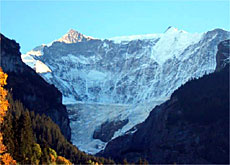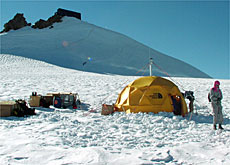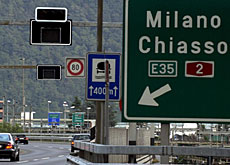Scientists say extreme weather is here to stay

Swiss scientists warn Europe could face more extreme weather patterns and temperatures similar to last summer’s heatwave.
Meteorologists said the high winds buffeting Switzerland and parts of Europe on Monday were not linked to the same phenomena.
Last summer’s record temperatures were considered by many scientists to be further evidence of global warming.
A Swiss study – published in the science journal “Nature” – points to similar extreme weather patterns becoming more frequent in Europe.
“Our simulations show that every second European summer is likely to be as warm, if not warmer, than the summer of 2003,” said Christoph Schär of the Federal Institute of Technology in Zurich.
More than 20,000 people are thought to have died across Europe as a result of last summer’s heatwave, which saw temperatures hit peaks of 40 degrees Celsius.
The hot and dry weather led to forest fires and severe drought in some areas. The World Health Organization has warned that the death toll from global warming will increase if current trends continue.
Climate change
Schär and his colleagues from the Swiss meteorological office, MeteoSwiss, produced simulations for climate conditions between 2071 and 2100, using records from the past 150 years.
Their calculations assume that greenhouse gases will rise to twice their current level by the end of the century.
The scientists said that, based on average temperatures since 1990, last summer’s heatwave was a freak event. Statistically, it should happen only once every 46,000 years, even after taking into account global warming.
They suspect that greenhouse gases, such as carbon dioxide, are affecting weather patterns as well as the temperature – a hunch confirmed by their simulations.
Schär suggests that last summer’s unusual conditions will probably be repeated in the future.
“By the end of the century, the mean would be more like 2003 and the maximum would be even warmer,” he said.
Record temperatures
In some parts of Europe last summer, temperatures were on average five degrees higher than normal. Such a rise is not unusual over a few days, but it is rare over three months.
According to Schär, if future summers see the average temperature rise, central Europe’s climate could become semi-arid, with conditions similar to those found around the Mediterranean. But the findings don’t rule out cold winters or wet summers.
Farmers are expected to face the biggest difficulties if the mercury rises. They will have to decide whether to plant crop varieties that are heat-resistant or to use others that can handle humid conditions.
Last summer’s heatwave led to crop losses of around SFr500 million ($411 million) in Switzerland alone.
Economic cost
Water supply and energy production are other sectors that could be affected by climate change.
According to the Swiss researchers, coming up with an appropriate response to rising temperatures and changeable weather patterns is difficult.
Schär says there are two possible strategies to follow: either adapt to the new conditions or fight global warming.
One solution would be to adhere to the Kyoto Protocol and reduce greenhouse gases. But nations producing 55 per cent of these gases have yet to ratify the agreement.
The United States, the world’s biggest producer of greenhouse gases, has refused to sign. Australia has also rejected the accord and Russia is still making up its mind.
Strong winds
Climate change was also in the news over the weekend when MeteoSwiss issued a storm warning.
Wind speeds reached between 70kmh and 100kmh overnight, peaking at 120kmh in some mountain areas. No major damage was reported, but stronger winds are expected on Monday night.
MeteoSwiss told swissinfo the wind and high temperatures were not unusual.
“The strong storm that has crossed over Switzerland is nothing more than a normal winter event,” said Christof Appenzeller of MeteoSwiss.
Meteorologists say the storm will not match Hurricane Lothar, which struck in 1999. Lothar had wind speeds of up to 160kmh and caused millions of francs’ worth of damage.
swissinfo with agencies
Switzerland, like much of Europe, suffered from a heatwave last summer, with temperatures well into the 30s.
More than 20,000 people are believed to have died as a result of the heat.
Crop losses in Switzerland were estimated to be around SFr500 million.
The World Health Organization has warned that if current trends in global warming continue, more heat-related deaths can be expected.
Swiss researchers say computer simulations show conditions such as those experienced during the summer of 2003 could repeat themeselves regularly in years to come.
Summer temperatures like those of 2003 could become the norm by the end of the century.
The scientists say that greenhouse gases could be affecting weather patterns as well as temperatures.
If warmer conditions persist, Switzerland’s future climate could be Mediterranean.

In compliance with the JTI standards
More: SWI swissinfo.ch certified by the Journalism Trust Initiative



You can find an overview of ongoing debates with our journalists here. Please join us!
If you want to start a conversation about a topic raised in this article or want to report factual errors, email us at english@swissinfo.ch.